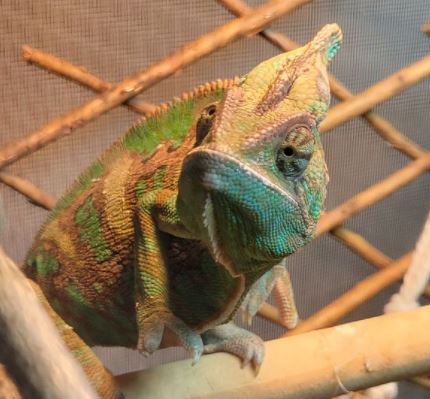What kind of UVB bulb for a chameleon is best?
There are different types of bulbs that you can use to provide the most optimum UVB exposure for your pet.
Some lamps have a mercury vapor arc tube with a compact fluorescent lamp, while others have a metal halide or mercury vapor discharge lamp combined with an ultraviolet-emitting phosphor coating on the inside of the glass envelope.
There are also variations in how many hours per day they need to be on and whether they need to be replaced annually or not.
Read more below!
Related Posts:
- Top 8 Best Misting Systems for Chameleons
- Bearded Dragon vs. Chameleon: Facts and Differences
- How to Keep a Chameleon Cage Warm?
- How to Clean the Bottom of a Chameleon Cage?
- What Plants to Put in a Chameleon Cage?
What Kind of UVB Bulb for a Chameleon?
Zoo Meds lamps are good for chameleons because they provide UVB. The power sun lamp can provide both heat and UVB in just one lamp. UVB and heat are necessary for chameleons to absorb calcium from the food they eat.
Calcium is what makes their bones strong and healthy.
Some lamps might not be able to provide both UVB and heat, so it’s important to check this before you buy a lamp for your chameleon.
Without this combo, chameleons will not be able to produce vitamin D3, which is required for them to absorb calcium from their food.
This means that they are at great risk of developing metabolic bone disease.
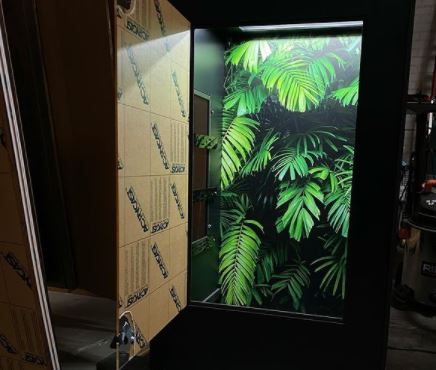
How to Know If UVB Is Good for My Chameleon?
Chameleons need 5 to 30 minutes of exposure to UVB light every day.
They absorb calcium and vitamin D3 from the sunlight via their skin. If your chameleon does not receive proper amounts of sunlight, then they may need a lamp with UVB.
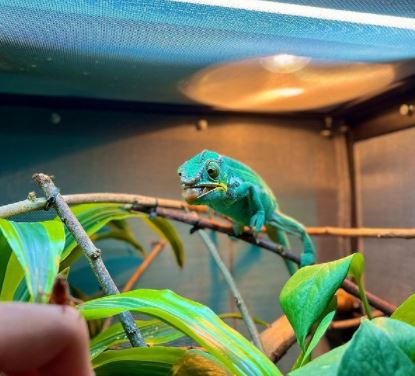
How Long Can a Chameleon Go Without a UVB Light?
Chameleons need about 12 hours of UV light daily, 10 being optimal.
These reptiles get this light from the sun. Since we cannot bring our chameleon outside for him to get sunlight, we need a special UVB lighting apparatus called a UVB light, which is available at your pet store.
The new LED lights are great and provide more heat than regular fluorescent tubes and don’t require as much wattage.
What Temperature Does a Chameleon Need?
For your chameleon, the temperature should be between 75 and 85 degrees Fahrenheit.
The basking spot should be at 85 to 90 degrees and the drop in temperature should be about 10 degrees at night. Your cage needs to stay above 70°F all the time.
What Temperature Does a Veiled Chameleon Need?
88 to 92 degrees Fahrenheit is ideal for your veiled chameleon.
The basking spot should be at 90 to 94 degrees, and the drop in temperature needs to be about 10 degrees at night. You can use either a regular incandescent light or an LED light with UVB bulbs to achieve these temperatures.

How to Determine the Right Chameleon Lighting to Use?
Here is an example problem that any chameleon owner may face:
I’m trying to find the best basking bulb for my panther chameleon.
I want to get the highest UVB output possible, but also something that will promote territories within his tank.
Right now, he is in a 20-gallon with one other male and they are constantly chasing each other around, though not attacking or anything, just being irritating.
I ordered the Zoo Med Ultra Sun 5.0 15-watt, and it seems to put off a decent amount of UVB (when turned to reflect inside), but it doesn’t seem like they’re getting much basking heat from it.
On the other hand, when I read reviews online about that bulb one person said their panther chameleon lived for 13 years and another person said that they had the same bulb up for over a year, but neither of those seem possible unless I bought a dud.
Which one should I get? Is there a certain wattage to look for in a basking bulb?
Here is our answer:
You have several options when it comes to UVB bulbs for your chameleon, but the best choice would be a larger coil-style bulb that emits greater amounts of UVB and heat simultaneously.
The Zoo Med 10.0 T5HO fits this description nicely. Its compact form factor helps to keep your chameleon’s home cool, but the 10 watts of UVB output is perfect for a 20-gallon enclosure.
The Zoo Med PowerSun bulb you have ordered will likely work well, but it emits much less heat than the T5HO bulb I recommended.
Chameleons are very small reptiles and thus need little amounts of heat to regulate their body temperature.
This means that they can often rely on basking in the sun or under special “basking lights” that only emit UVB and some heat, but not much light for extended periods of time.
For your purposes, I would recommend using a bulb with both UVB and heat (try the Zoo Med PowerSun 25.0) and see which of the two your chameleon prefers.
If he prefers the basking lamp, then use it. If you find him sitting at his normal basking spot under the T5HO or hanging out next to it, try swapping its position with the PowerSun bulb every so often and see if this encourages him to bask under it more.
This way, you can maximize the use of the UVB and heat-emitting light bulbs, allowing your chameleon to regulate his body heat and absorb as much vitamin D3 as possible.
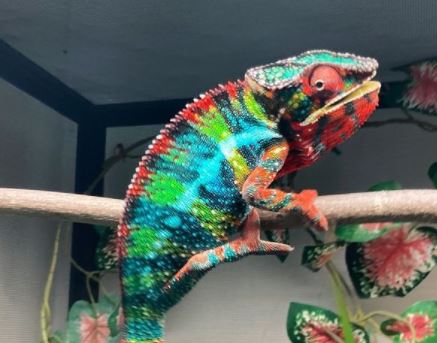
Frequently Asked Questions About Chameleons
1. How Many Watts Should a Basking Light Be for a Chameleon?
The bulb might be 100 watts, but the height of both the basking branch and the bulb must be changed to get the desired temperature.
The distance between the basking bulb and your chameleon’s basking branch should be 10 to 12 inches.
2. How Long Can a Chameleon Go Without Food?
Chameleons usually only take one or two big insects at a time, so they will most likely be able to survive about ten days without eating.
You should try to offer food as soon as possible after that period, though, because going too long without eating is bad for them since if the insect goes too long without being digested, it can ferment inside of your chameleon’s stomach, which isn’t good.
3. How Do You Hold a Chameleon Correctly?
Place your hand over the back of the chameleon and put your pointer finger on his chest and then cup him with your hand.
Keep in mind that they tend to pee when held, so don’t hold them for too long. You can also let it crawl up your arm or even perch on top of your head if it is willing to do so.
If you are having trouble getting it to climb onto you, try putting some honey on your nose, which attracts insects and may help the chameleon think that crawling up your arm is an escape route for bugs.
Never keep a chameleon overnight in a container because they room to move around freely otherwise
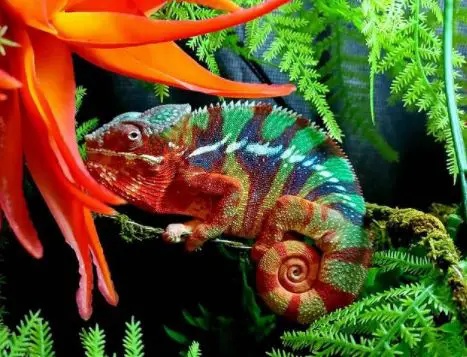
4. How Long Do Veiled Chameleons Live?
Veiled chameleons are expected to live about ten years when in captivity, although there are some that have lived up to eleven.
Some of this variance may depend on how well they are cared for in captivity, but their life span seems largely dependent on genetics as well.
5. Do Chameleons Bite?
No, chameleons do not bite and they don’t even have any jaws that can open large enough to bite a human.
They use their tongues to eat bugs and will flick them with the tongue to capture them, but they cannot sink their teeth into you.
Conclusion
What kind of UVB bulb for a chameleon is best?
Chameleons are fascinating creatures, but they also require specialized care. The type of UVB bulb you use is crucial to the well-being of your pet chameleon.
Make sure that you have a reliable resource for information about what kind of bulbs can be used in different terrariums and set up an appointment with an expert if you don’t know where to start!
Key points for selecting the right UV bulb for your chameleon:
Proper UV (ultraviolet) lighting is essential for the health and well-being of your chameleon. When it comes to selecting the right UV bulb, there are several factors to consider. Here’s a guide to help you make an informed choice:
1. UVB vs. UVA:
- Chameleons require UVB (ultraviolet B) light, which helps them metabolize calcium and synthesize vitamin D3. UVA (ultraviolet A) is also beneficial, as it enhances your chameleon’s natural behaviors and perception.
2. Linear Fluorescent or Compact Bulbs:
- Two main types of UVB bulbs are available: linear fluorescent tubes and compact bulbs. Linear tubes are preferred for their better UVB coverage.
3. UVB Output:
- Select a UVB bulb with an appropriate UVB output. Chameleons generally require a UVB rating of 5.0 to 10.0, depending on their species.
4. Fixture Compatibility:
- Ensure the UVB bulb is compatible with the fixture you have in your chameleon’s enclosure. Some bulbs require specific fixtures.
5. Positioning:
- Position the UVB bulb within the enclosure to create a proper basking spot. Chameleons should be able to bask within 6-12 inches of the bulb.
6. Length of Bulb:
- Consider the length of the UVB bulb. Longer bulbs provide a broader UVB exposure area. Choose a size that suits your enclosure.
7. Reptile-Specific Bulbs:
- Use reptile-specific UVB bulbs, as they are designed to produce the appropriate UV spectrum for reptile needs.
8. Reflectors:
- Reflectors can help maximize the UVB output and distribute it more evenly in the enclosure. They are especially useful in larger enclosures.
9. Changing Bulbs Regularly: – UVB bulbs degrade over time, even if they still emit visible light. Change the bulb as recommended by the manufacturer, usually every 6-12 months.
10. Dusting and Supplementation: – In addition to UVB lighting, provide a well-balanced diet and consider calcium and vitamin D3 supplementation, as chameleons may not always get enough from UVB exposure alone.
11. Daily Lighting Schedule: – Establish a regular lighting schedule that mimics a natural day-night cycle. Chameleons require both UVA and UVB exposure during daylight hours.
12. Overhead Lighting: – Place the UVB bulb overhead in the enclosure, rather than on the side. Chameleons bask and thermoregulate by moving closer or farther from the light source.
13. No Glass or Plastic Filters: – Do not use glass or plastic filters or screens between the UVB bulb and your chameleon, as these can block UVB radiation.
14. Measure UVB Levels: – Invest in a UVB meter to monitor the actual UVB levels in your chameleon’s enclosure. This ensures your chameleon receives the appropriate exposure.
15. Observe Behavioral Changes: – Monitor your chameleon’s behavior and physical health. Proper UVB lighting should lead to increased activity and overall well-being.
In summary, choosing the right UV bulb for your chameleon is essential for their health. Select a UVB bulb with the appropriate output and position it correctly within the enclosure. Regularly change the bulb, provide a balanced diet, and maintain a suitable lighting schedule to ensure your chameleon receives the UV exposure they need to thrive.
Further Reading:
- 7 Best Lighting for Chameleons: What Is the Best Bulb?
- 7 Best Plants for Turtle Tank
- How to Decorate a Chameleon Cage?
- How to Raise Humidity in a Chameleon Cage? A Complete Guide

